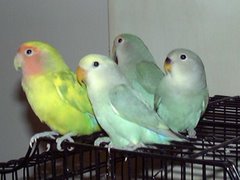Lovebirds Droppings- The Secrets Revealed
 Most of the pet bird lovers are confused with the normal droppings of lovebirds with that of abnormal one. Generally the lovebirds pass watery droppings. As a lovebird owner you should know the constituents of normal droppings.
Most of the pet bird lovers are confused with the normal droppings of lovebirds with that of abnormal one. Generally the lovebirds pass watery droppings. As a lovebird owner you should know the constituents of normal droppings.
Lovebird's droppings consist of three separate components including feces, urine and urates. Since the bird pushes the droppings out of one orifice, the vent, all three portions of the droppings are mixed in the cloaca before being passed out of the body.
The Feces
The feces of the lovebirds are solid and worm-like, may be dark green in color. In addition to this, the color of the feces varies mostly what the bird has recently consumed. It can be alarming to the owner if he sees reddish color feces, as this may be interpreted as blood. Hence it is utmost important for the lovebirds breeder to see what their lovebirds are consuming, so that color changes can be correctly evaluated.
If the fecal portion of the droppings is very sticky, tarry, dark, and dark green, then the lovebird doesn't eat any solid food for the past 24 hours. Usually the lovebird breeders often mistaken for digested blood in the droppings, but it is really a kind of bile (biliverdin) from the liver.
The Urine
You can notice the watery droppings in case the feces portion is missing in the droppings, which is an indicative of increase in the urine level. Most of the lovebirds breeders will consider that their bird is passing diarrhea, but it is not so. If the feces is solid with no urine at all, it is not diarrhea.
Missing of brown or green solid fecal portion with watery droppings is an indicative of diarrhea. Some types of diarrhea will show gas bubbles in the droppings, which is an indicative of presence of anerobic bacteria.
Urates
The last part of the lovebirds dropping is urates. It is the end product of protein metabolism in the avian system. This product is filtered in kidney and evacuated in droppings. If your lovebird is showing yellow and green urates, then the avian patients are suffering from liver problem and chlamydophila infection respectively.
As bottom line, the lovebird breeders should aware that when birds consume greens or fruits, it would lead to diarrhea. Some of the breeders are having false opinion about this fact.
Moreover, if your lovebird is nervous, the droppings would be more watery, which is due to high blood pressure than normal.
Any deviation in the lovebirds dropping should brought to the notice of your avian vet immediately to save your valuable lovebirds life.








 Free Ads For Bloggers
Free Ads For Bloggers

